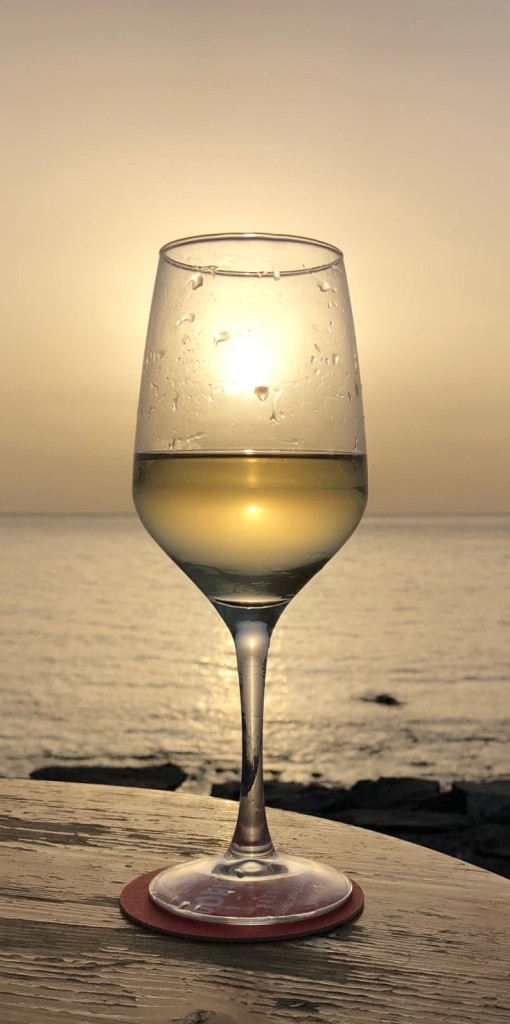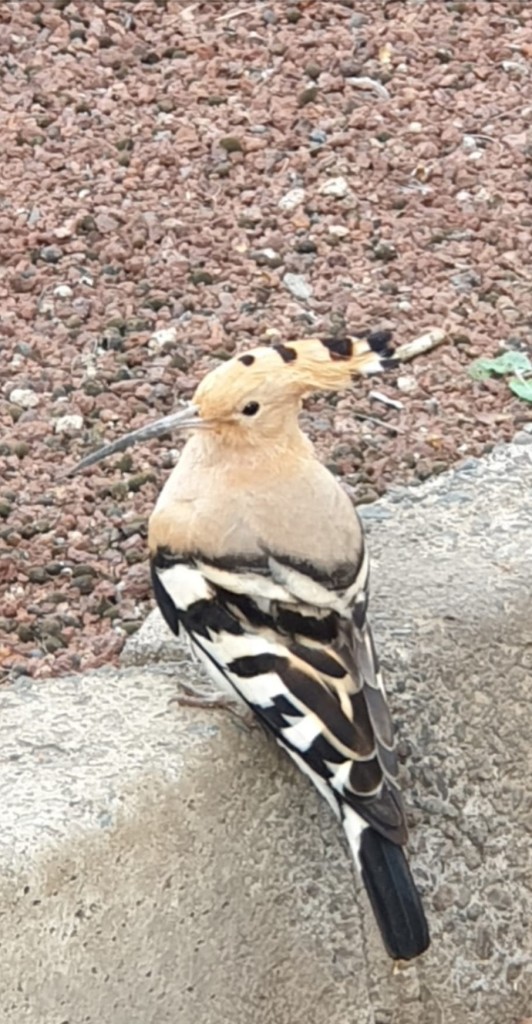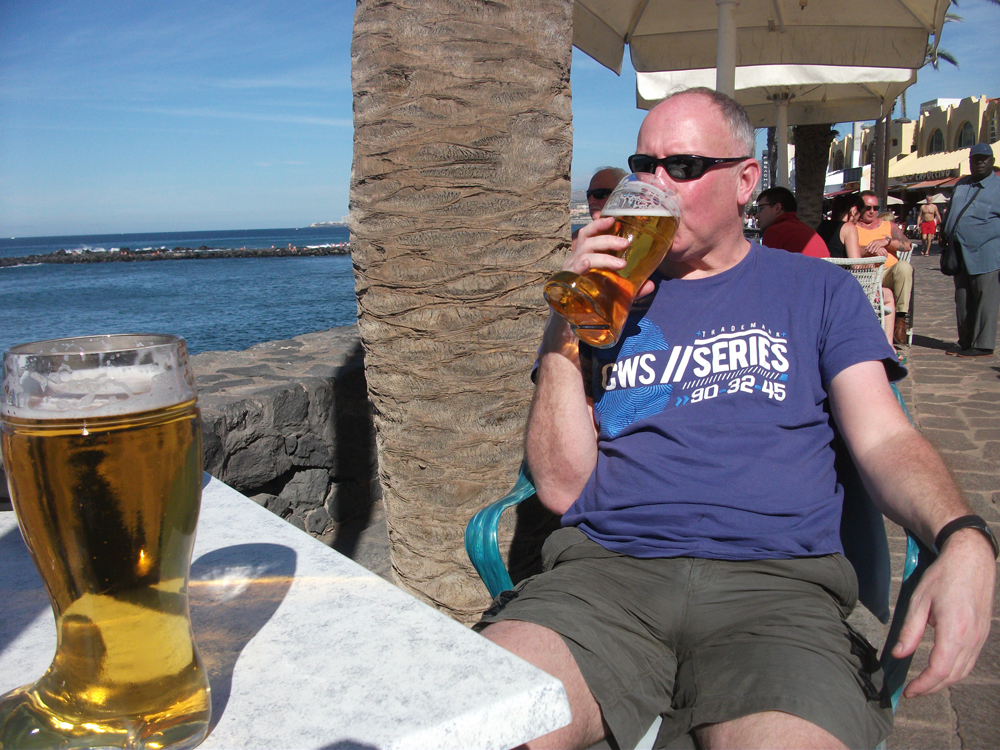Bit late with January’s post but that’s what happens when you toddle off to Tenerife for a mid-winter break.
I didn’t make Weymouth this January, so my first venture of 2015 was the annual jaunt over to Rutland Water with the WMBC.
It was cold and icy, which is always preferable to coldish and muddy and wet (although it did begin to spit at the tail-end of the day).
Saw plenty of Red Kites en route but there was not a huge amount to get excited about once out on the reserve. There was a Smew, which seemed to occupy the exact same place as last year’s little duck – probably the same one – and a fair old smattering of wildfowl on the water. A Green Sandpiper popped up, and there were decent views of a Goldeneye – whenever it wasn’t diving under water to dredge up some duck food.
For those dying to see what a Goldeneye looks like – and I’m sure you do – here’s an illustration from the RSPB website:
 I went to see East is East at the Alexandra Theatre with Dave and Annie. The performance was excellent – especially with the brilliant Jane Horrocks doing her stuff, but what really sent us reeling was the price of a plastic bottle of lager: £5.10!!! That was worth three exclamation marks for sure! (Oops! – there’s another one). Of course, I expect to pay over the odds at some of these things but that’s just taklng the p*ss! These exclamation marks and asterisks are having a right old day out today.
I went to see East is East at the Alexandra Theatre with Dave and Annie. The performance was excellent – especially with the brilliant Jane Horrocks doing her stuff, but what really sent us reeling was the price of a plastic bottle of lager: £5.10!!! That was worth three exclamation marks for sure! (Oops! – there’s another one). Of course, I expect to pay over the odds at some of these things but that’s just taklng the p*ss! These exclamation marks and asterisks are having a right old day out today.
Any way that was the mini-rant out of the way – here’s a review from Paul Marston of the Birmingham Evening Mail plus a photo, which I’m sure they won’t mind me sharing:

Having written this semi-autobiographic play about multi-cultural family issues, Ayub Khan Din might be expected to give a convincing performance in the lead role, and he does just that.
He plays 1970s Salford chip shop owner George Khan, married to his white English wife for 25 years, and struggling to cope with some of the views and attitudes of their six sons and a daughter brought up in this country, starkly contrasting with his own strict Pakistani-Muslim beliefs.
There are times when George – his kids call him Ghenghis when he’s not in earshot – appears tyrannical as he wrestles for control in their back-to-back home, and others when you sympathise with him in a story that mixes raw emotion with sparkling humour.
Nor does he get all his own way with his loyal wife Ella, beautifully played by TV and film actress Jane Horrocks, who can fight her corner even after receiving one painful thump during a row. Although his threats to bring his Pakistani wife over to England if she doesn’t toe the line never seem too genuine.
There’s a touch of Mrs Brown’s Boys about the action at times, with the family never economical with the use of dodgy language, including the F-word, which might surprise a few people. The build-up to the youngest son, Sajit (Michael Karim), needing to be circumcised also has a cringe factor.
But the play is more memorable for its humour, particularly in the second act when a comfortably off Pakistani couple arrive to discuss the proposed arranged marriage of their daughters to two of the Khans’ sons. A piece of art work showing the naked front torso of a woman also turns up to create a bit of mayhem.
Sally Banks adds another dimension to the fun as the children’s white Auntie Annie.

If I may continue with the bone-idle use of other people’s accounts, here’s Paul Hands summation of our monthly fell- walk around Blakedown in Warwickshire. There are continuing conversations about the legality of our title – Birmingham University Fell Walkers – as only Trev works at the Uni now, and its been a long time since any of us did anything remotely fellish…
Anyway, here’s Paul with the gen:
Verge side parking on Sandy Lane, among the trees, south of Hunter`s Lodge.
GR 883774
Map: OS map Explorer 219
Getting there:
From Birmingham follow A456 (Hagley Road). Continue through Hagley and Blakedown. As you leave Blakedown and rise up a slight hill, the road becomes a dual carriageway and you leave the 30mph limit. Look for a small lane on left at the end of a line of trees. Turn left and park soon after the sharp right hand bend.
The Walk:
This walk goes through pleasant undulating north Worcestershire countryside south of the Clent Hills. On a good clear there are some pleasant viewpoints. The lunch stop is at the Robin Hood, Drayton. A pleasant hostelry with a full menu including snacks and several local ales. It has become more of a restaurant in recent times but still retains a separate bar area. However I think it`ll be boots off and they don`t allow dogs in. I can guarantee some mud.
Route:
From start N to Blakedown. NW past golf course to Waggon Lane. Then via bridle paths N & E to Churchill. Stakenbridge, Harborough Hill, Knoll Hill, Broome. Then S via Egg Lane to Drayton (lunch). From pub we circle via Drayton Pool, Mount Farm & Shutt Hill to Hillpool. NW alongside brook then Barnett Hill and back to cars.
I thought I’d throw in all the ‘getting there’ details in case anyone fancied checking it out. He was right about the mud though.
Mid-week, and the Flat Earth Society’s film night had a sheepish feel to it, tipping a fleecy nod to the Chinese Year of the Sheep and all things ovine.
First up was an episode from Aardman Animation’s Shaun the Sheep. Then a bizarre livestock and agricultural educational documentary all about sheep produced by The Texas Company (TEXACO). The main feature was an independent American film rarely screened at the time of its release due to copyright issues surrounding its soundtrack: Charles Burnett’s Killer of Sheep.
This film depicts the culture of urban African-Americans in a run down district of Los Angeles. The film’s style is often likened to Italian neorealism, and it remained in obscurity for nearly thirty years, garnering much critical and academic praise and earning a reputation as a lost classic.
The National Society of Film Critics National Society of Film Critics chose the film as one of the 100 Essential Films to see. In 1990, Killer of Sheep was selected for preservation in the United States National Film Registry for being “culturally, historically, or aesthetically significant.”
I still preferred Shaun the Sheep.

January was running out pretty swiftly so eight of us (a new record for the sneaky winter week club) took off to Tenerife for some R&R – its tough doing stuff…
If you take one excellent hotel – the H10 Gran Tinerife, in Playa de las Americas – add a commendable breakfast and evening buffet, throw in a selection of afternoon beers, stir in a heavier assemblage of evening alcohol, and serve up with lashings of entertainment – admittably mainly dressed up as cheesy tributes to Rod Stewart, the Blues Brothers, Elvis, Freddie Mercury and generic soul singers – then I would say you have the recipe for a memorable holiday – except that I’d be overcooking the dining metaphor somewhat so I’ll just shut up and say we had a grand old time.
Here be photos:

























































































































